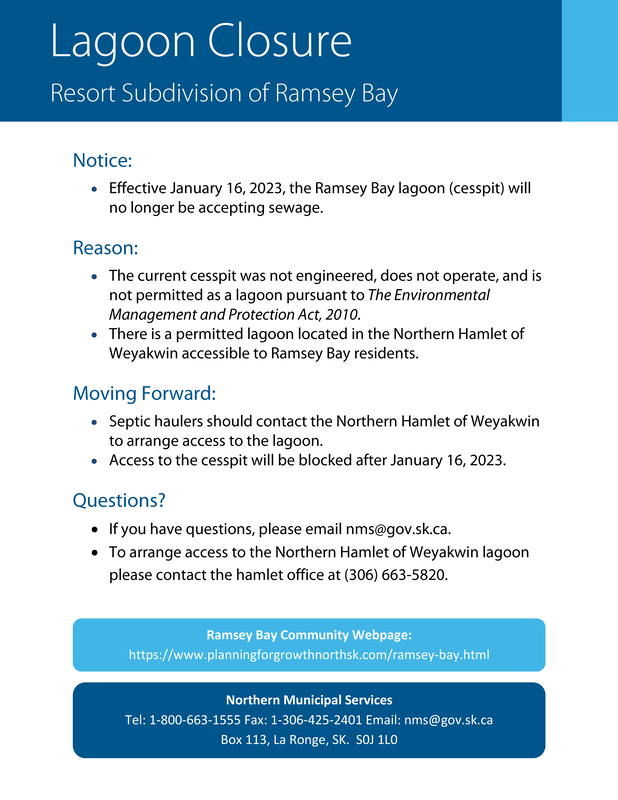Ramsey Bay Lagoon Closure
| Weyakwin 2022 Water and Sewer Bylaw | |
| File Size: | 463 kb |
| File Type: | |
Lagoon Closure FAQ
Last updated February 7, 2023
Why is the Ramsey Bay lagoon being decommissioned?
Why wasn’t a new lagoon built for Ramsey Bay residents?
What was Ramsey Bay’s contribution to the Hamlet lagoon upgrade?
Why was Ramsey Bay’s contribution calculated based on a 46% share?
How much will the lagoon cost Ramsey Bay residents annually?
How do I access the Hamlet lagoon?
How much does it cost to access the Hamlet lagoon?
It appears the existing lagoon is not "closed". Any idea when that will happen?
What is the per load charge for non-commercial haulers?
Are Fobs going to be transferable?
What is considered a septic truck or trailer?
Why is the Ramsey Bay lagoon being decommissioned?
- The lagoon that served the Ramsey Bay area was not a permitted sewage works facility under The Environmental Management and Protection Act. Building a lagoon requires a large capital and ongoing operating investment and so it was determined that it was economically feasible and sustainable for the residents of Ramsey Bay to utilize the Northern Hamlet of Weyakwin (Hamlet) lagoon rather than build two within close proximity.
Why wasn’t a new lagoon built for Ramsey Bay residents?
- Building a new lagoon for Ramsey Bay residents has been deemed financially unfeasible and unsustainable. A sewage works system assessment would have been required, and there was an expectation that major upgrades would be required to bring the lagoon into compliance with current regulations. From a financial standpoint, hauling to the Hamlet’s lagoon was opportune, as the current unpermitted lagoon was in a severe state of disrepair. The cost to upgrade the unpermitted lagoon was determined to be upwards of $2 million or more. The Hamlet lagoon was sized to accommodate current and future wastewater flows from the Ramsey Bay area.
What was Ramsey Bay’s contribution to the Hamlet lagoon upgrade?
- The Hamlet’s lagoon was designed to support Ramsey Bay residents. Ramsey Bay contributed $63,592 to the upgrade of the Hamlet’s lagoon. The area of the treatment/primary cell was required to be constructed 59% larger to accommodate Ramsey Bay’s highly concentrated waste. The secondary cell was constructed to be 27% larger to accommodate Ramsey Bay’s volume. This upgrade to support Ramsey Bay was significant and calculated to be $498,920. The Hamlet’s eligibility for the Northern Water and Sewer program was critical to Ramsey Bay cost savings, and the share was decreased to $63,592.
Why was Ramsey Bay’s contribution calculated based on a 46% share?
- The 46% calculation was based on a detailed engineering study. The per capita generation for the Hamlet was based on information from the Sewage Pump Station and the Ramsey Bay generation was based on permanent population off-season volumes. Although Ramsey Bay generates significantly less wastewater per person, the concentration is a lot higher which was important for designing the lagoon.
- The lagoon has a 20-year design period. A peak season volume and an off-season volume for Ramsey Bay was noted. The lagoon design factored both population and concentration of the waste. Ramsey Bay required more area for the treatment/primary cell because the concentration is so high, and it needed to be based on the peak season. The Hamlet required more storage volume (secondary cell) because they generate a lot more liquid, but at a lower concentration. The engineering study then looked at the construction costs for the primary cell(s) and secondary cells, and the total cost share portion was calculated. This percentage was not simply based on a per capita formula. The design study was reviewed by project manager engineers and regulatory agencies and accepted.
How much will the lagoon cost Ramsey Bay residents annually?
- The annual operation and maintenance costs of the lagoon is recovered through user fees. The sewage truck operator pays per dump and charges back to the cabin owner, or the non-commercial hauler pays per dump.
How do I access the Hamlet lagoon?
- Contact a licensed sewage hauler; or
- Contact Water Security Agency to obtain permits to haul sewage to the Hamlet:
- Water Security Agency
300 - 2365 Albert St. Regina, SK, S4P 4K1
Phone: (306) 787-0913 Fax: (306) 787-0780
Email: liquiddomesticwaste@wsask.ca; and
- Water Security Agency
- Contact the Hamlet office at (306) 663-5820 arrange access.
How much does it cost to access the Hamlet lagoon?
- Information relating to the lagoon access can be obtained by contacting the Hamlet office at (306) 663-5820. A copy of the Bylaw to Provide for the Water Rates and Sewer Service Charges in the Northern Hamlet of Weyakwin has been approved by the Saskatchewan Municipal Board.
It appears the existing lagoon is not "closed". Any idea when that will happen?
- The lagoon is unpermitted and officially closed by the Water Security Agency. We are working with contractors to sign and berm the site. Even without the sign and berm in place, there is no dumping allowed.
What is the per load charge for non-commercial haulers?
- $2.00 per 1000 litres, with a minimum charge of $4.00.
Are Fobs going to be transferable?
- No. Fobs are assigned to individual haulers with a $100 deposit.
What is considered a septic truck or trailer?
- A person hauling their own sewage with a trailer modified to haul sewage or with a portable septic tank in the back of their truck and dispose the content in the lagoon are considered septic haulers and will need a permit from the Water Security Agency.
- Recreational vehicles such as a motorhomes or campers are not considered a septic hauler, as they are not primarily designed or used for hauling sewage.
